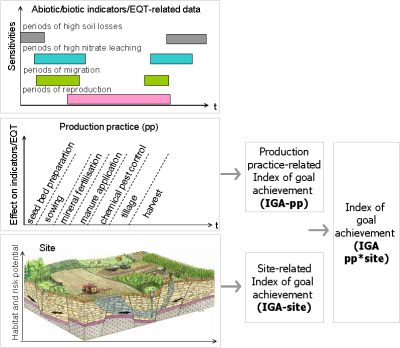Enivironmental Impact Assessment in MODAM
 The environmental impact assessment of the model comprises the ecological indicators which were incorporated into the model by Meyer-Aurich (2001), Sattler (2008) and Stachow et al. (2002). The assessment of the impact of the cropping practices on the ecological indicators is implemented with the help of a fuzzy tool with rules derived from expert knowledge and parameters preset by the choosen cropping practices. To calculate the degree to which an environmental objective is met the site-specific sensitivity towards the enironmental objective is combined with the effect the choosen cropping practice has on this objective.
The environmental impact assessment of the model comprises the ecological indicators which were incorporated into the model by Meyer-Aurich (2001), Sattler (2008) and Stachow et al. (2002). The assessment of the impact of the cropping practices on the ecological indicators is implemented with the help of a fuzzy tool with rules derived from expert knowledge and parameters preset by the choosen cropping practices. To calculate the degree to which an environmental objective is met the site-specific sensitivity towards the enironmental objective is combined with the effect the choosen cropping practice has on this objective.
Starting with an environmental quality target (EQT) and the facts known about the related biotic or abiotic indicator in a first step this information is linked to that available about the different agricultural production practices. This leads to the calculation of their suitability to reach the defined EQT, indicated by the index of goal achievement of each production practice (IGA-pp). In a second step the indicator-related and site-related information are combined, which yield in the calculation of the site-specific index of goal achievement (IGA-site). Finally, in a third step, by interrelating both indices the site-specific index of goal achievement per production practice (IGA-pp*site) is assessed as the final result. The resulting index of goal achievement can take values between 0 and 1, indicating the relative target specific performance of a cropping practice.
Learn more about the different MODAM environmental impact assessment indicators.
Literature
Meyer-Aurich, A. 2001. Entwicklung von umwelt- und naturschutzgerechten Verfahren der landwirtschaftlichen Landnutzung für das Biosphärenreservat Schorfheide-Chorin. Bern, Hannover: Verlag Agrarökonomie. (Agrarökologie, Bd. 41) 137 p.
Sattler, C. 2008. Ökologische Bewertung landwirtschaftlicher Produktionsverfahren mittels Fuzzy Logic und Diskussion wirtschaftlicher und sozialer Einflußgrößen auf die Umsetzbarkeit umweltschonenderer Verfahren. Humboldt Universität zu Berlin, Landwirtschaftlich Gärtnerische Fakultät. Dissertation (in Vorbereitung).
Stachow, U., J. Hufnagel, M. Glemnitz, G. Berger, J. Bachinger, P. Zander and C. Sattler. 2002. Indicators of landscape functions related to modifications and patterns of agricultural systems. OECD expert meeting on: Agricultural Landscape Indicators, 7th - 9th October 2002, Oslo, Norway. 15 p.

